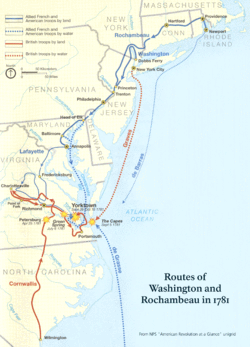This Week in History:
October 2 - 8, 1781
Gen. Washington Begins Siege of Yorktown
October 2011

Siège de Yorktown by Auguste Couder, c.1836. Rochambeau and Washington giving their last orders before the battle.. |
After more than six years of shooting war—if you count from the encounter at Lexington and Concord—the final battle of the American Revolutionary War was waged in Yorktown, Virginia between Oct. 6 and Oct. 17 of 1781. While Yorktown will not go down in the annals of military history as a great strategic confrontation, it is a significant historical turning point, and should be remembered as such.
Crucial to the victory, of course, was the military, as well as political alliance between Louis XVI's France, and the young American Republic. That alliance had been forged by Benjamin Franklin in 1778, and had finally resulted in the deployment of French forces, especially the crucial Navy, to the American continent. The French fleet played a decisive role in Gen. George Washington's outflanking of the British forces.
Going into 1781, the major British force, under Gen. Henry Clinton, was located in New York City, while a force of approximately 7,500 troops under Gen. Charles Cornwallis, about one-quarter of the number of British troops in America, was in the South. Although Cornwallis had been smashing the American Army in the Carolinas, he eventually was forced by Gen. Nathanael Greene's guerrilla tactics to retreat to the Yorktown Peninsula in Virginia. Cornwallis knew he was "holed up," and looking at disaster, if he did not get reinforcements, and he sent to New York to get them.
But Clinton, thinking that Washington was going to attack New York City (which was Washington's original plan), delayed on sending troops, or the fleet which Cornwallis would need in order to break the blockade by sea, which the French Navy under Admiral de Grasse had imposed, by defeating the British Southern fleet under Admiral Graves, at the mouth of Chesapeake Bay. In effect, that decision doomed Cornwallis, and the British overall effort.

Goodrich, S. G. (1875). A Pictorial History of the United States. Philadelphia: J. H. Butler & Co., 277. |
|
Source: U.S. National Park Service.
|
General George Washington personally was commanding ground forces deployed around Yorktown, flanked by the French General Rochambeau, and his two top aides Alexander Hamilton and the Marquis de Lafayette. The joint American-French force amounted to approximately 16,000 men, as against Cornwallis's 7,500. Washington began a siege on Oct. 6, and actual bombardment of the British defenses on Oct. 9. On Oct. 14, Hamilton and Lafayette led the taking of two British redoubts (defensive barriers), and, as Washington expressed it, the battle was decided.
General Cornwallis made a list minute effort to prepare to evacuate across the York River, but a storm made the highly risky attempt, out of the question. On Oct. 17, Cornwallis received a note from Washington calling for an end to the "useless effusion of blood" (Washington was no Rambo), and decided to surrender his entire force to the Americans.
The official surrender occurred on Oct. 19. Because Cornwallis decided to stay in his tent, under the cover of illness, the final submission was made by his second in command, to General Washington's second in command, Gen. Benjamin Lincoln.
When the news of the surrender arrived in London, it hit the war party like a ton of bricks. The government of Lord North fell, and the British began to move toward serious peace negotiations with the Americans, which culminated in the Treaty of Paris in 1783, and put the United States of America on the world map, as the world's premier republic, and victor against the British Empire.
The original article was published in the EIR Online’s Electronic Intelligence Weekly, as part of an ongoing series on history, with a special emphasis on American history. We are reprinting and updating these articles now to assist our readers in understanding of the American System of Economy.

